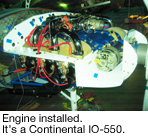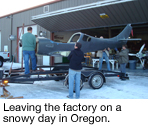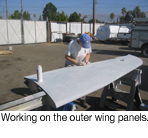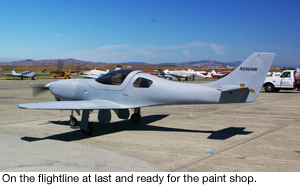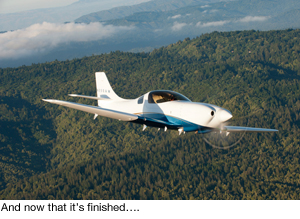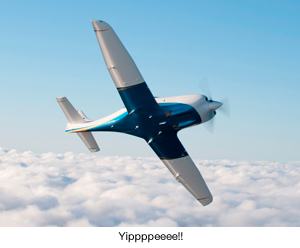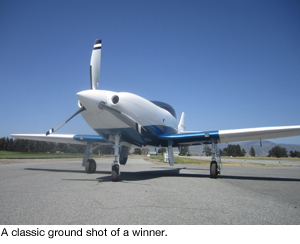Andy Werbacks Grand Champion Lancair Legacy By David Gustafson
| The flight home began early on the last day of AirVenture. Andy Werback took the active runway, advanced the throttle and headed west. In the eight+ hours of flying it would take to get back to his home in Sebastopol, one has to wonder how many times he glanced at the Gold Lindy trophy near him and smiled. “Grand Champion Kit Built”. Among the hundreds of homebuilts at AirVenture, Andy’s stood out. Somehow all the toil and trouble seemed like it was worth it. It’s like winning the Oscar for Best Picture…maybe better because of the challenges it places on one person. Andy’s in rare company, being one of a couple dozen kit builders who have taken home the award. Of the 30,000 Experimental Amateur Built aircraft on the FAA Registry, the few who have won Grand Champion status really have something to their credit as craftsmen.
EAAs Grand Champion Award is a tribute to achievement, to passion and commitment. It’s recognition for someone who’s attention to detail is a magnitude of order above the rest of us. It’s a reflection of impeccable taste and consistency that raises refinement to a level of enviable artistry. Andy’s aviation Odyssey began in 1974, when he got his private pilot’s license. He worked his way up to buying a Skylane, but in the period of 1985 to 2003, he was so busy with his family and his career in designing software, that he stopped flying and sold the 182. He then picked it up again in 2003 with Cessnas. Then in 2002 Andy and his wife, Sam, went to AirVenture for the first time and discovered a whole new world. He soon found himself looking for an airplane he could build. He liked the idea of composites and looked long and hard at the Cozy, but then worried that it was too complicated and would take too long to build. (It’s interesting that the Grand Champion Plans Built trophy went to a Cozy III this year…one that took to 20 years to complete!) His cousin, Tom Lotina, who had a role in motivating Andy and Sam to visit Oshkosh, suggested he visit the Lancair factory which was near his home in Bend, OR.
When he “discovered” the Lancair Legacy and got talking to the people behind the kits, he knew it was a fit and eventually decided on a fixed gear version. He bought that kit from the factory in 2004. About the same time, he decided it was time for a career change. As a software engineer he had become
In December 2008 he turned up at the Lancair factory for his second experience with their intense one-week builder assist program. It’s one of those Put-The-Basic-Structure-Together programs. Like framing a house, initial
At this time, Andy was working for a maintenance shop and set up his project in an open space at the back of the shop. There, in the early mornings, evenings, weekends and on holidays, over a period of two years, he passed on the temptation to go fly so he could work on the thousands of details leading to the point where the FAA says “bless, bless”. He did get a lot of help and advice from a local friend of his and fellow Lancair Legacy builder, Don Barnes. Don was quite willing to give advice or lend an extra set of hands when needed and his Sam pitched in occasionally. Most of the hours, however, were spent in isolation, plodding away at this piece or that, studying the manual and making things fit. One of his tasks was staying ahead of the actual construction by ordering parts or setting up the sequence to complete a system in time for installation. It’s a kind of time management and planning exercise that doesn’t end until the plane is finished.
As he had in the factory, he started over with the tail, making sure the fit and alignments were correct, installing the controls and assuring that they functioned properly, along with prepping the surface for primer with the seemingly endless hours of fill and sand. He also worked on the fairings to assure they fit properly. He worked his way up the tail cone prepping the outside skin for primer and working the inside to assure the controls had the proper support and would move smoothly and effortlessly. Though most of the fiberglass work was completed when he left the factory, there were still about a dozen places where he needed to work with fiberglass or carbon fiber to provide mounting points or reshape something, for the most part on the outside. His biggest project was rebuilding the wingtips. This requires fiberglass layups to provide the new shape and accommodate the customized lighting he wanted to install. He used conventional strobes, and LEDs for the nav lights and trailing edge lights (in place of a rudder installation) with appropriate heat sinks so the trailing edge could be narrow with a couple of blips in it to accommodate the LEDs. This gives him double the tail light illumination when you’re directly behind. One of the wingtips is as bright as the typical rudder installation. Deviating from the factory tips, he swept back the wing tip instead of going straight back and he gave it a bit of a curve. He installed landing and taxi lights near the wing root at the fuselage and has the lights wired for the new “wig-wag” function which really makes an aircraft pop, even in daylight. There is a small fairing in the gap between the ailerons and the flaps. Andy didn’t like the way it was shaped and spent considerable time filling in and sanding it to make it look like it should (mind you, Andy’s idea of “what it should look like” may be a bit above what the rest of us would accept). “I made it look neat and consistent,” he said.
Ron Jones has a company called Legacy Innovations and has developed a kit of fairings for the wings, flap gaps and aileron hinges. Andy installed all of them and added a few of his own. When it came to the panel, Andy contracted with Aerotronics again to design and cut out the holes for the instruments and paint it. Andy did the installation and wiring. He put in a GRT Horizon HX EFIS, True Track Digiflight II Autopilot, Garmin 430W, SL40 backup com, a GTX 327 Transponder, PM 8000 Audio Panel, and a NAV Worx ADS 600B in and out box which gives traffic information and complies with FAAs 2020 ADS-B ruling. As a backup to the GRT, he has a 3” electric attitude indicator RC Allen 2600. There is no vacuum system in the plane.
Before AirVenture, Andy won Grand Champion at Copperstate. It was a warm up. When asked what contributed to his winning at Oshkosh, he said: “There are a lot of nice airplanes at Oshkosh and the competition is pretty stiff. What makes this airplane special is that it’s a Lancair Legacy, so people like the lines. It’s a compact sporty looking airplane. Don Barnes did the paint scheme for his airplane and I copied it with his permission. He did his in red, I did mine in blue. People like the color and the simple flow on the airplane. We paid a lot of attention to making sure everything’s square, everything’s finished. All the details just added up to be the right combination.” The paint scheme obviously contributed to the impact of the Legacy. He had turned to Juan Solario at T&P Aero Refinishers, Salinas, CA, to give it that touch of class.
Though finished in 2010, it was too late to fly off the hours and make Oshkosh. He came to AirVenture for the first time in 2011 and won a Bronze Lindy. That meant he could come back and compete again. You can move up in the trophies, but you cannot move down. He had garnered a lot of advice from the judges and went home after 2011 with a list of recommended changes or upgrades, like using leather in the baggage compartment. He incorporated everyone’s suggestions and wound up with a winner.
Andy had high praise for the Lancair Company, indicating they were always there for him in responding to questions or providing parts. He took advantage of their transition training program with both of his Legacies and he followed their advice in hiring a professional test pilot to make the first couple flights/hours in the airplane. “If you follow the advice of the factory, you’re not going to have any problems keeping up with the airplane,” he said. “On the first flight, they couldn’t get the gear up; when I flew it the first time, I couldn’t get the gear down, but I used the emergency procedure and brought it home safely. With that kind of distraction, however, it’s good to have some time in type.” Andy plans to sell his FG version and expects to get a lot of years of use out of his RG Legacy. It’s a beauty…without peers.
Air-air photo is by Chris Luvara www.stickandrudderphoto.com |



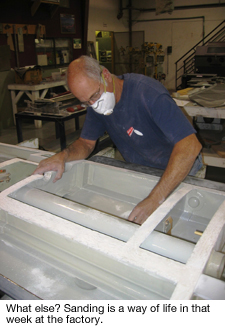
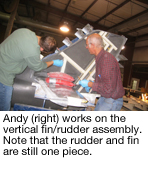
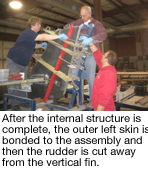


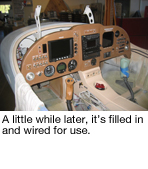

 tired of laying people off as more and more jobs migrated overseas. So he used his Lancair kit to fulfill part of the requirements for his A&P license. When he finished the Legacy in 2006, he had his license and a new part time job as an A&P. Though he was very happy with the fixed gear on which he’d hung a Lycoming IO-360 turbo normalized, he couldn’t help developing a case of envy for extra performance that came with the retractable gear version sporting a Continental IO-550 normally aspirated engine. In addition to the increase in engine size, the cruise speeds went from 165 knots true in the FG, to 210 knots true at 12.5 gph in the RG…with the option of bumping it up to 235 knots true if he was in a hurry and didn’t care about the fuel burn. So two years after completing the fixed gear, he bought a used kit that had been sitting around, mostly untouched for eight years. It was serial number 12 in the RG series. It had the retractable gear, knowing he could advance on the knowledge he’d gained from the first project.
tired of laying people off as more and more jobs migrated overseas. So he used his Lancair kit to fulfill part of the requirements for his A&P license. When he finished the Legacy in 2006, he had his license and a new part time job as an A&P. Though he was very happy with the fixed gear on which he’d hung a Lycoming IO-360 turbo normalized, he couldn’t help developing a case of envy for extra performance that came with the retractable gear version sporting a Continental IO-550 normally aspirated engine. In addition to the increase in engine size, the cruise speeds went from 165 knots true in the FG, to 210 knots true at 12.5 gph in the RG…with the option of bumping it up to 235 knots true if he was in a hurry and didn’t care about the fuel burn. So two years after completing the fixed gear, he bought a used kit that had been sitting around, mostly untouched for eight years. It was serial number 12 in the RG series. It had the retractable gear, knowing he could advance on the knowledge he’d gained from the first project.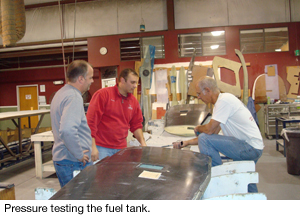
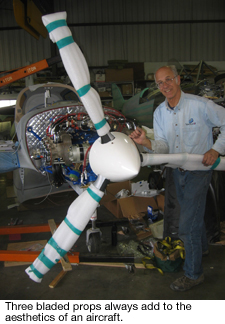 progress is swift and impressive, giving the impression that a lot has been accomplished in a small amount of time. With the kit, the two halves of the fuselage have already been bonded together; the firewall is in place along with the bulkheads. What needs attention are the tail group, wings and center section. Arriving on site, Andy and Sam began with the tail, applying the upper surface of the horizontal stabilizer and elevator over the pre-placed and bonded ribs and spar. After securing the horizontal structure in place, he applied the left face of the rudder and cut the rudder away from the permanent vertical fin. The hinges were already installed; the skins just needed cutting to make it a separate piece. He created a leading edge for the rudder. Moving forward, he finished up the wing structure, completed the fuel tanks (inspected it, installed vent check valves) before sanding and bonding the top skins of the two outer 7-1/2’ wing panels. Then he did a pressure test of the fuel tank. The sealant and other fuel system parts, along with the push rod tubes for control were pre-installed. Moving inboard, he attached the 10’ center section of the wing which becomes an integral part of the fuselage. All of this work is done in the factory jigs which are ready for use and perfectly aligned. The jigs alone represent a couple of month’s worth of work that Andy didn’t have to struggle with. In a week all of the structural components are assembled and bonded. It’s beginning to look like a real aircraft. What some people don’t realize is that there remains about 2000 hours of work to get it finished. In the dead of winter, Andy mounted the components of his aircraft onto a trailer and drove down from snowy Redmond, OR to sunny San Jose.
progress is swift and impressive, giving the impression that a lot has been accomplished in a small amount of time. With the kit, the two halves of the fuselage have already been bonded together; the firewall is in place along with the bulkheads. What needs attention are the tail group, wings and center section. Arriving on site, Andy and Sam began with the tail, applying the upper surface of the horizontal stabilizer and elevator over the pre-placed and bonded ribs and spar. After securing the horizontal structure in place, he applied the left face of the rudder and cut the rudder away from the permanent vertical fin. The hinges were already installed; the skins just needed cutting to make it a separate piece. He created a leading edge for the rudder. Moving forward, he finished up the wing structure, completed the fuel tanks (inspected it, installed vent check valves) before sanding and bonding the top skins of the two outer 7-1/2’ wing panels. Then he did a pressure test of the fuel tank. The sealant and other fuel system parts, along with the push rod tubes for control were pre-installed. Moving inboard, he attached the 10’ center section of the wing which becomes an integral part of the fuselage. All of this work is done in the factory jigs which are ready for use and perfectly aligned. The jigs alone represent a couple of month’s worth of work that Andy didn’t have to struggle with. In a week all of the structural components are assembled and bonded. It’s beginning to look like a real aircraft. What some people don’t realize is that there remains about 2000 hours of work to get it finished. In the dead of winter, Andy mounted the components of his aircraft onto a trailer and drove down from snowy Redmond, OR to sunny San Jose.